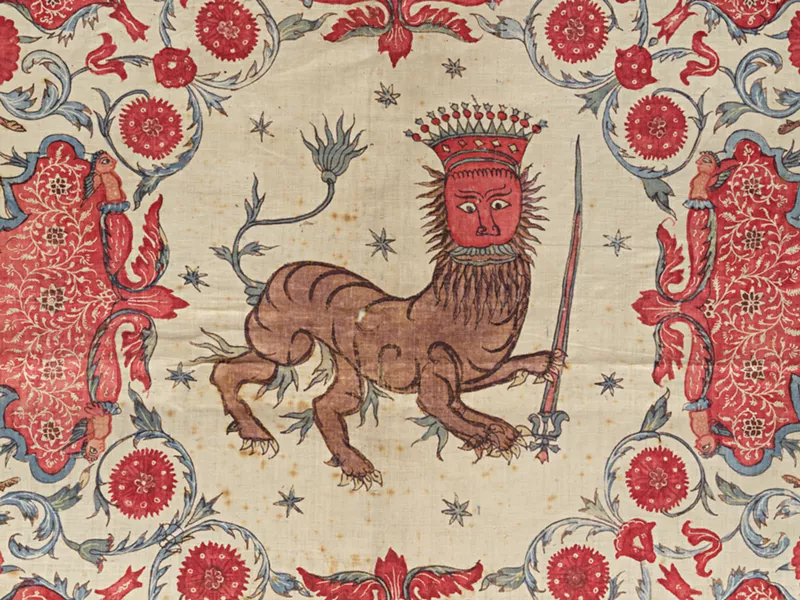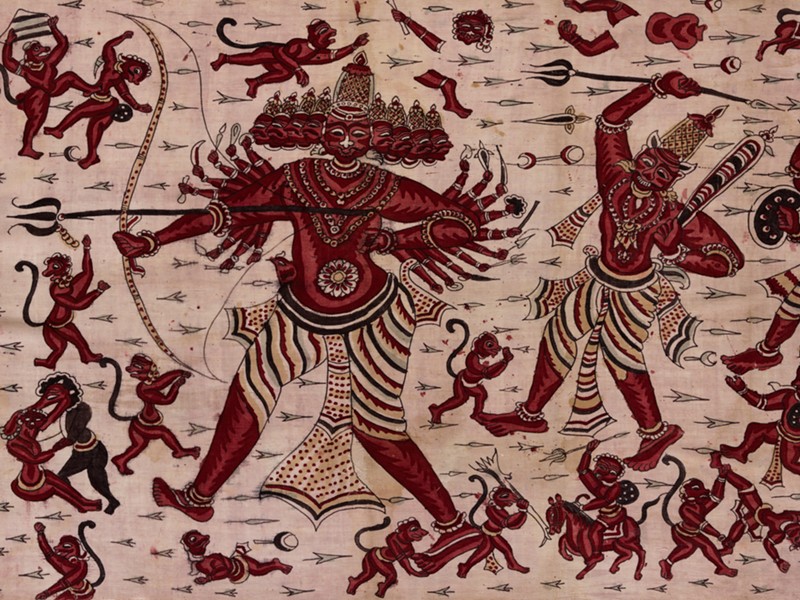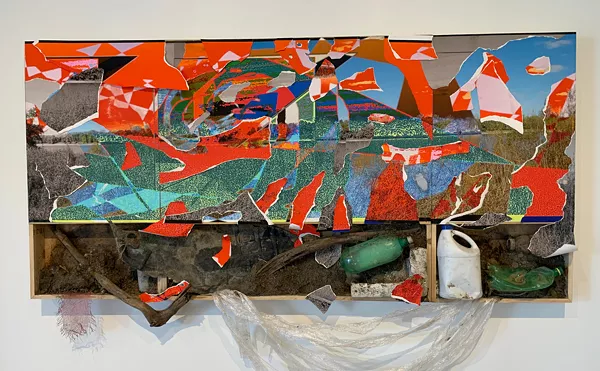
Courtesy Royal Ontario Museum / Brian Boyle
Woman's Jacket (Wentke) with Flowers and Phoenixes” c.1700s; textile: Indian for European market; construction and trim: Dutch; cotton, painted mordants and resist.
The lights at the Saint Louis Art Museum’s (1 Fine Arts Drive, 314-721-0072, slam.org) latest exhibition are dimmed to protect the ornate vestments and tapestries that reside there — the fabrics, centuries old, are highly sensitive to light. Yet not even low lighting and the passage of centuries could keep the warm reds and deep blues of the textiles on display from popping. Indian chintz was made to last, and it’s done just that.
The exhibition, Global Threads: The Art and Fashion of Indian Chintz, tells the story of Indian chintz, a fabric as revolutionary as it is beautiful. From the 17th century onward, this cotton textile, which Indian artisans spent centuries perfecting, dominated the global textile scene. Coveted for its brilliant colors and intricate designs, chintz transformed fashion, industry and global trade, and was sought everywhere from East Asia to Egypt to Great Britain.
“The most exciting thing about this exhibition is that it really tells the story of a cloth that truly changed the world. This is technologically advanced, visually creative, and that really helps shape our kind of modern understanding of global trade and fashion today,” says Genevieve Cortinovis, the Andrew W. Mellon Foundation assistant curator of decorative arts and design and co-curator of the exhibition’s presentation in St. Louis.
There are a few criteria for a textile to be considered chintz: it must be cotton, the designs must be hand painted without the use of machinery and the dyes generally made from substances taken from the natural world, such as blue from indigo or red from madder. Chintz can take on a myriad of forms, from ornate tapestries and vestments in Iran to protective pouches for porcelain tea sets in Japan. The designs are equally as open to interpretation, ranging from historical and religious narratives to purely decorative patterns.

Courtesy Royal Ontario Museum / Tina Weltz
“Wall or Bed Hanging (Palampore)”; Indian for European market; cotton, painted mordants.
“The designs can be geometric; they can be floral; they can be narrative; they can be figural,” says Philip Hu, curator of Asian art and co-curator of the exhibition. “There's no one look to chintz.”
While remarkable in its beauty, what really made chintz singular on the global textile stage was the complex methods of producing dyes and mordants, or binding agents, that went into its production. This innovation of Indian artisans’ let them design elaborate fabrics in an array of uniquely fade-resistant colors.
“Imagine if all the clothes that you're wearing could never be washed, and if you did, all the colors would come off immediately,” Hu says. “I mean, you would be quite upset, right? So when the Indians discovered this method of making textiles, where you could have bright and beautiful designs, but they would not wash away, and they would be colorfast, it really became a kind of revolution in the textile world.”
Though visually stimulating, Global Threads is as interested in exploring the history of chintz as it is the aesthetic of it. Each gallery within the exhibition tells a piece of this story. The first room serves as an introduction to chintz, while subsequent rooms illuminate the way Indian artisans were able to adapt their creations to fit the desires of foreign markets, including Iran, Indonesia and France. One gallery, titled “Cotton and the Consequences of Desire,” highlights the way chintz catalyzed the industrial revolution and intensified cotton production in the United States.
The exhibition also features an audio-visual component spotlighting contemporary Indian chintz artists who continue to advance the art form not only to keep its beauty alive but to draw attention to environmental responsibility and sustainable practices in the age of fast fashion.

Courtesy Royal Ontario Market / Brian Boyle
“Ceremonial Textile with Battle Scene from the Indian Epic Poem the Ramayana”, c.1700s; Indian for Balinese or Sulawesi market; cotton, painted mordants and dyes.
“Chintz is alive and well today in India,” Hu says. “There are not too many people making it, but the people that do now have very important concerns about sustainability and responsibility to the environment. They realize that if they continue to only use natural dyes, that will have a much less debilitating effect on the environment as opposed to other printers and designers who use chemical dyes and other artificial elements.”
The exhibition concludes with a display of modern Indian chintz, including that of an artist featured in the aforementioned audio-visual component.
“We wanted to end the show with this sort of modern take on Indian chintz and to again emphasize the great variety that there is in this textile design,” Hu says.
Global Threads is produced and circulated by the Royal Ontario Museum in Toronto, Canada. While select pieces are from the Saint Louis Art Museum’s collection, including a chintz-inspired Japanese dish and a 19th-century American quilt with a chintz design, most of the fabrics on display are courtesy of the Royal Ontario Museum.
“We're just really lucky to have that material here,” Cortinovis says.
You can check out Global Threads now through January 8, 2023. Tickets are $12 for adults, $10 for seniors and students, and $6 for children aged 6 to 12. The exhibition is free on Fridays and anytime for museum members.






